spare tire CHEVROLET CAVALIER 1996 3.G Owners Manual
[x] Cancel search | Manufacturer: CHEVROLET, Model Year: 1996, Model line: CAVALIER, Model: CHEVROLET CAVALIER 1996 3.GPages: 372, PDF Size: 19.73 MB
Page 226 of 372
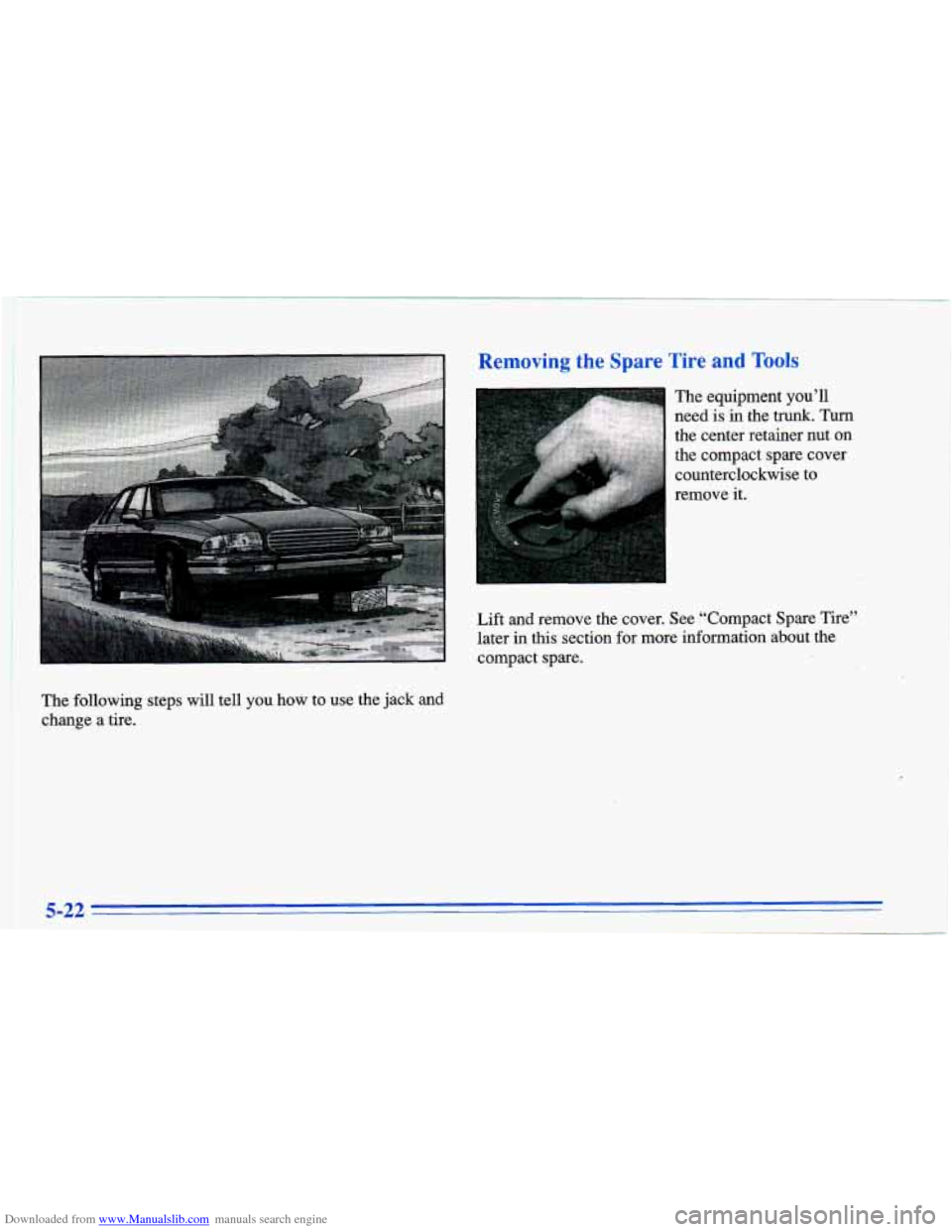
Downloaded from www.Manualslib.com manuals search engine need is in the t&. Turn
the center retainer nut
on
the compact spare cover
counterclockwise to
remove it.
Lift
and remove the cover. See “Compact Spare Tire”
later in this section for more information about the
compact spare.
The following steps will tell
you how to use the jack and
change a tire.
5-22
Page 227 of 372
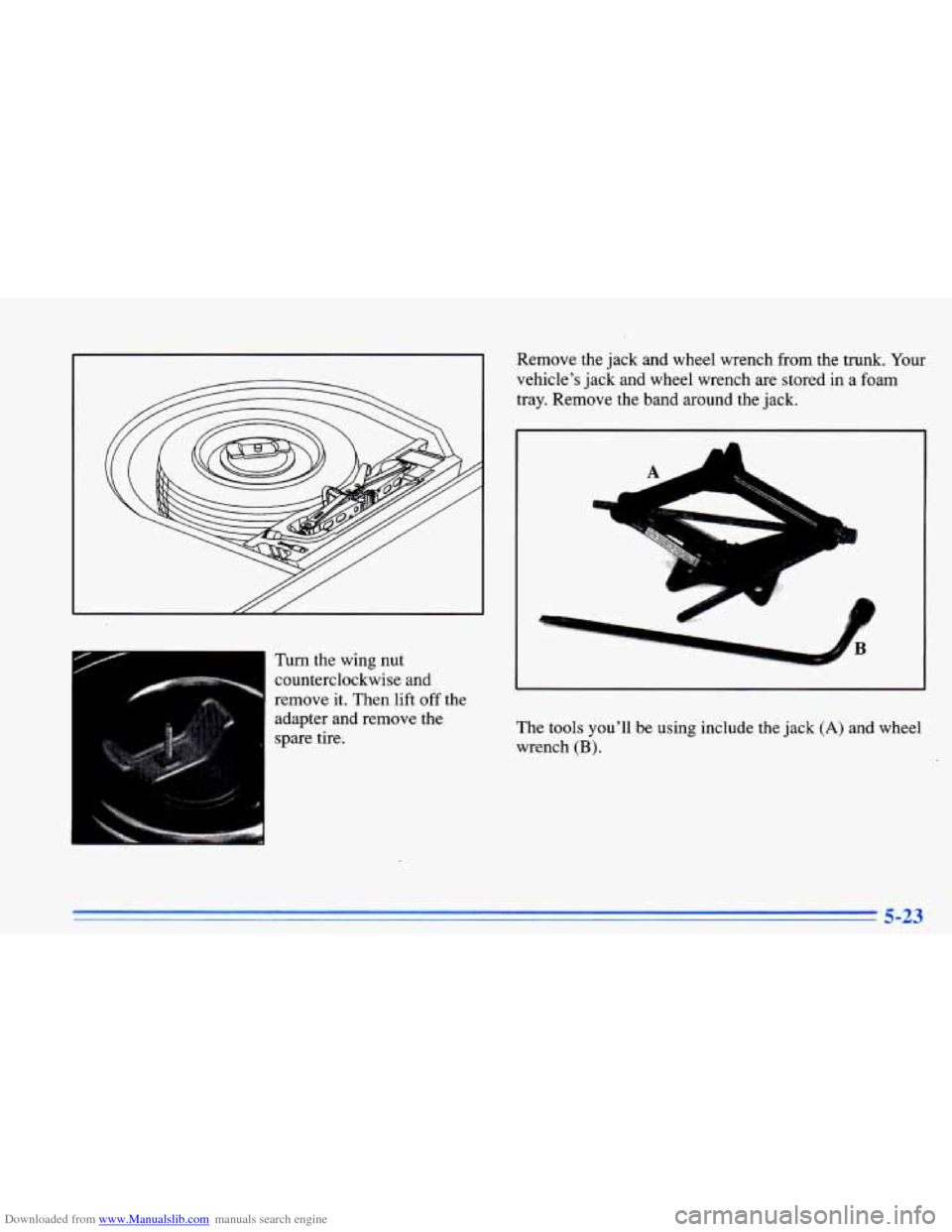
Downloaded from www.Manualslib.com manuals search engine Turn the wing nut counterclockwise and
remove it. Then lift
off the
adapter and remove the
spare tire. Remove the
jack and wheel wrench
from the trunk. Yo1
vehicle’s jack and wheel wrench are stored in a foam
tray. Remove the band around the jack.
The tools you’ll be using include the jack
(A) and wheel
wrench
(B).
5-23
Page 228 of 372
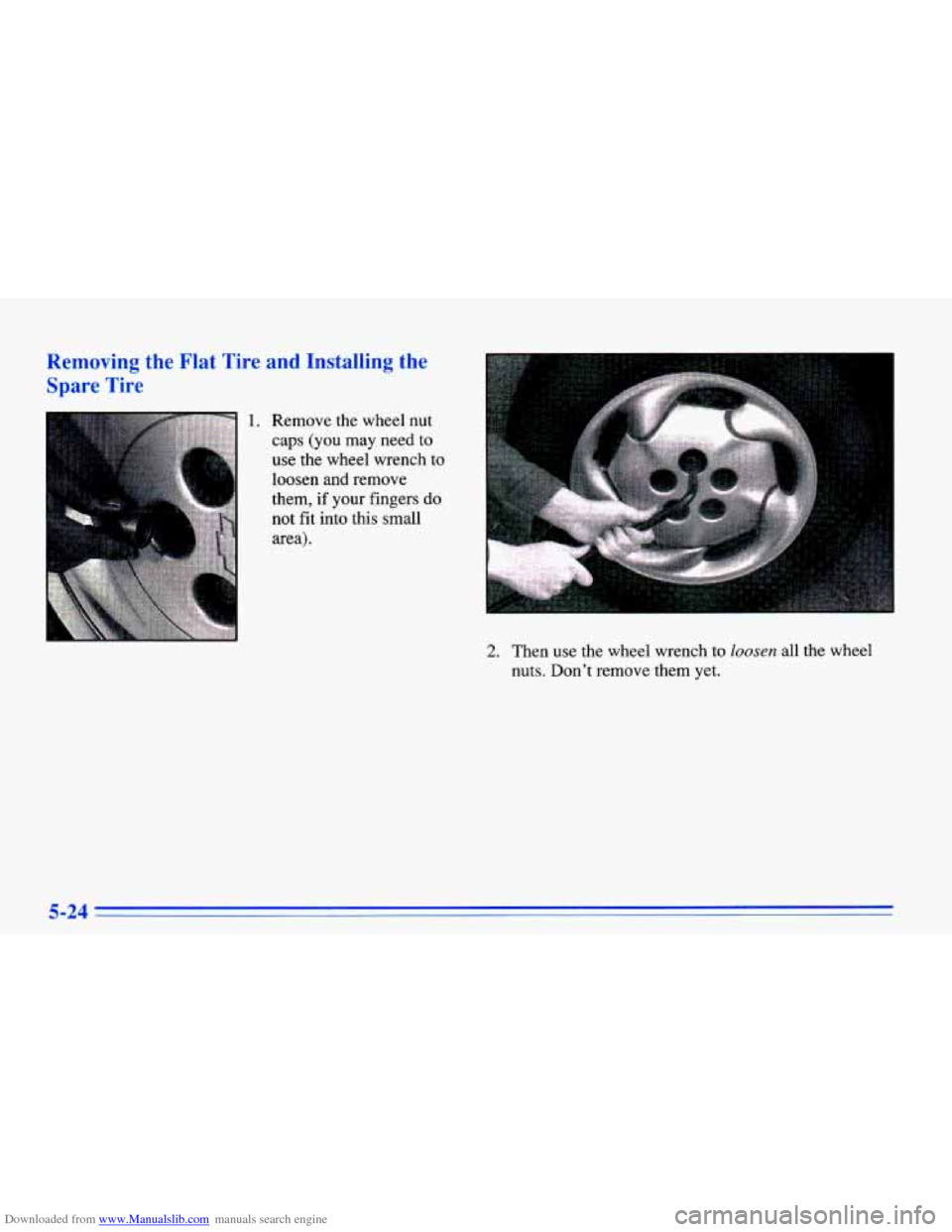
Downloaded from www.Manualslib.com manuals search engine Removing the Fiat Tire and Installing the
Spare Tire
Remove the wheel nut caps (you may need to
use the wheel wrench to
loosen and remove
them,
if your fingers do
not fit into this small
area).
2. Then use the wheel wrench to loosen all the wheel
nuts. Don’t remove them yet.
L 3A
Page 230 of 372
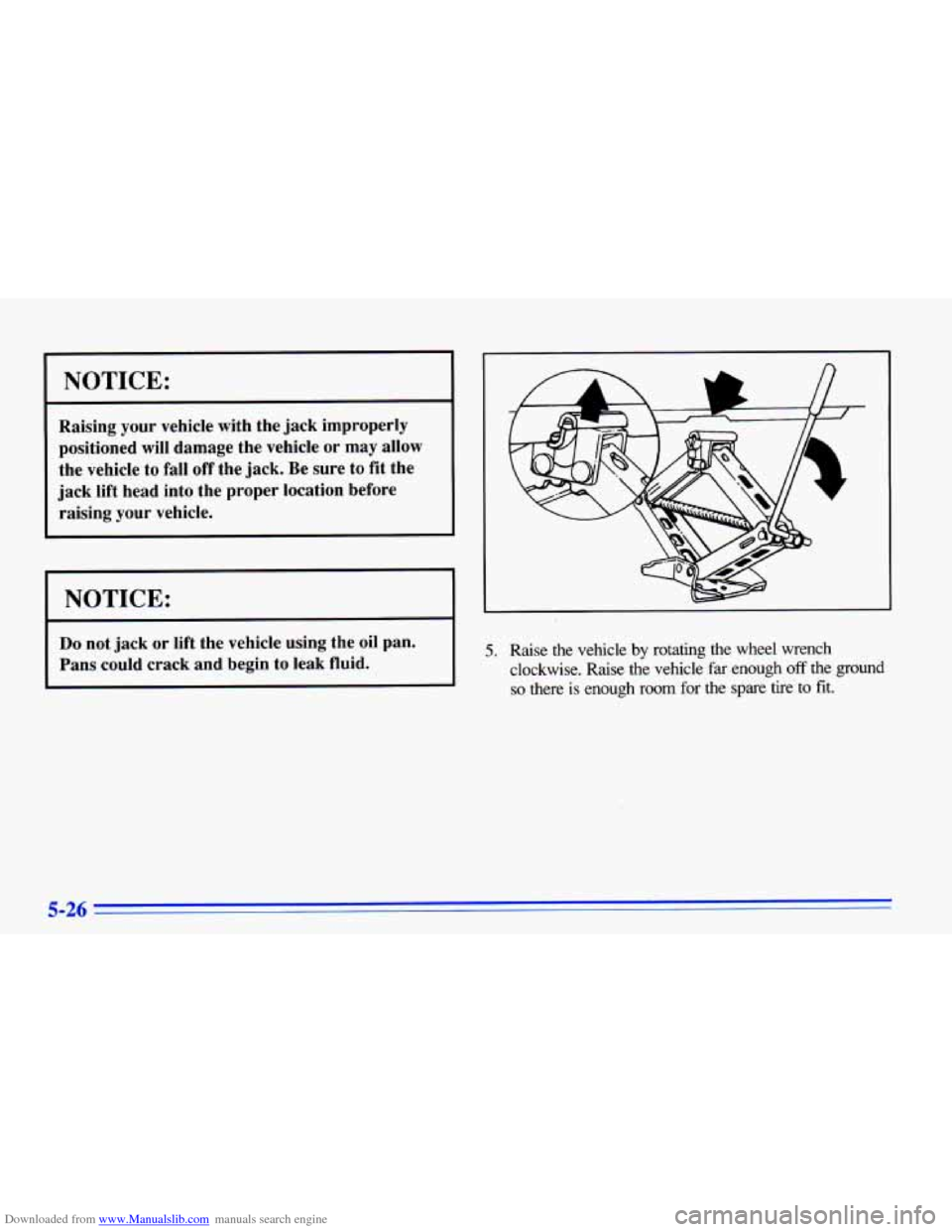
Downloaded from www.Manualslib.com manuals search engine I NOTICE:
I I
Raising your vehicle with the jack improperly
positioned will damage the vehicle or may allow
the vehicle to fall off the jack. Be sure to fit the
jack lift head into the proper location before
raising your vehicle.
Do not jack or lift the vehicle using the oil pan.
Pans could crack and begin to leak fluid.
1
A
n
5. Raise the vehicle by rotating the wheel wrench
clockwise. Raise the vehicle far enough
off the ground
so there is enough room for the spare tire to fit.
5-26
Page 231 of 372
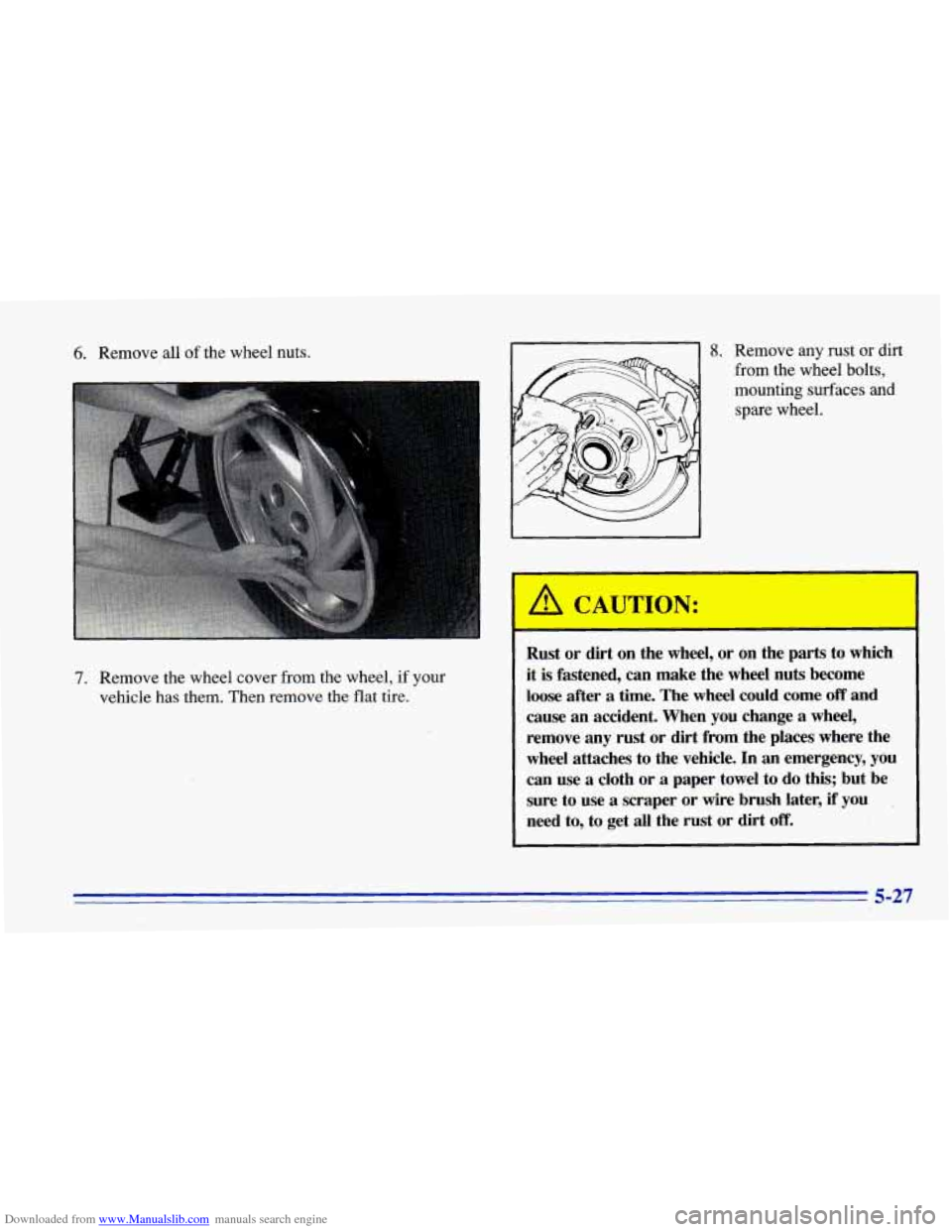
Downloaded from www.Manualslib.com manuals search engine 6. Remove all of the wheel nuts.
7. Remove the wheel cover from the wheel, if your
vehicle has them. Then remove the flat tire.
8. Remove any rust or dirt
from the wheel bolts,
mounting surfaces and spare wheel.
A CAUTION:
I- -
Rust or dirt on the wheel, or on the parts to which
it is fastened, can make the wheel nuts become
loose after
a time. The wheel could come off and
cause an accident. When you change
a wheel,
remove any rust or dirt from the places where the
wheel attaches to the vehicle. In an emergency, you
can use
a cloth or a paper towel to do this; but be
sure to use
a scraper or wire brush later, if you
need to, to get
all the rust or dirt off.
5-27
Page 233 of 372
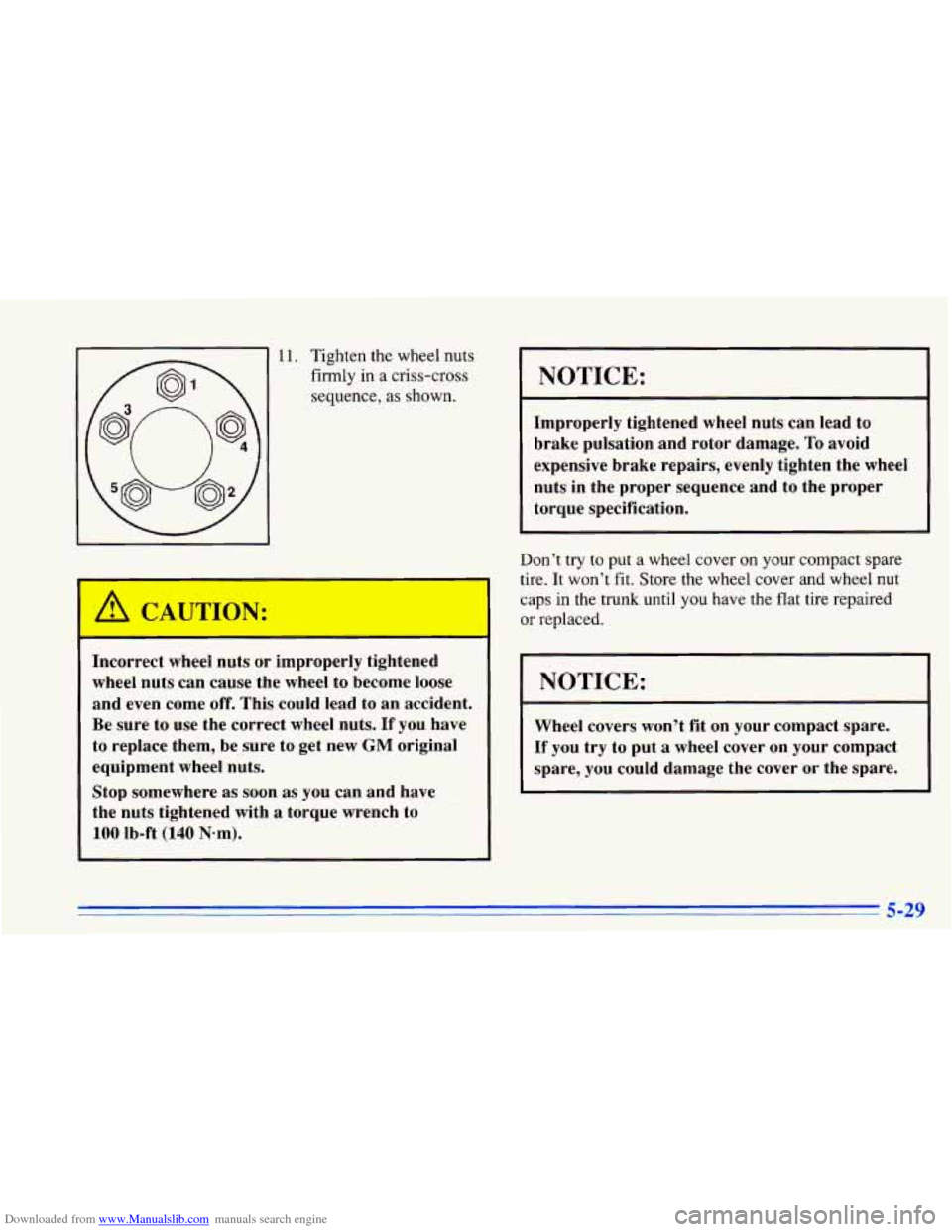
Downloaded from www.Manualslib.com manuals search engine A CAU [ON:
11. Tighten the wheel nuts firmly in a criss-cross
sequence,
as shown.
Incorrect wheel nuts or improperly tightened
wheel nuts can cause the wheel to become loose
and even come off. This could lead to an accident.
Be sure to use the correct wheel nuts. If you have
to replace them, be sure to get new
GM original
equipment wheel nuts.
Stop somewhere as soon
as you can and have
the nuts tightened with
a torque wrench to
100 Ib-ft (140 N-m).
NOTICE:
Improperly tightened wheel nuts can lead to
brake pulsation and rotor damage.
To avoid
expensive brake repairs, evenly tighten the wheel
nuts in the proper sequence and to the proper
torque specification.
Don’t try to put a wheel cover on your compact spare
tire. It won’t fit. Store the wheel cover and wheel
nut
caps in the trunk until you have the flat tire repaired
or replaced.
NOTICE:
Wheel covers won’t fit on your compact spare.
If you try to put a wheel cover on your compact
spare,
you could damage the cover or the spare.
5-29
Page 234 of 372
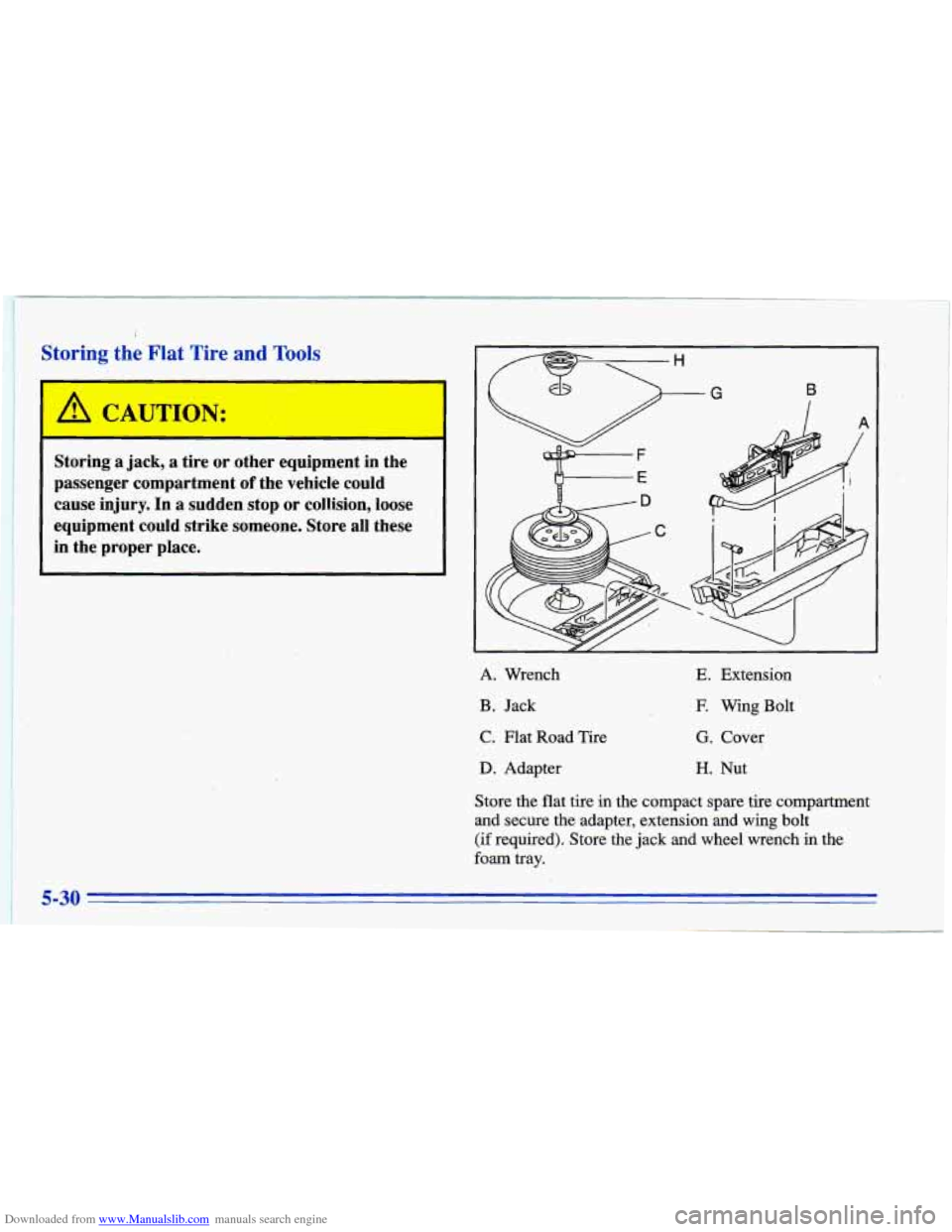
Downloaded from www.Manualslib.com manuals search engine Storing the Flat Tire and Tools
A CAUTION:
Storing a jack, a tire or other equipment in the
passenger compartment
of the vehicle could
cause injury. In a sudden
stop or colli.sion, loose
equipment could strike someone. Store all these in the proper place.
A. Wrench E. Extension
B. Jack E Wing Bolt
C. Flat Road Tire G. Cover
D. Adapter H. Nut
Store the flat tire in the compact spare tire compartment
and secure the adapter, extension and wing bolt
(if required). Store the jack and wheel wrench in the
foam tray.
5-30
Page 235 of 372
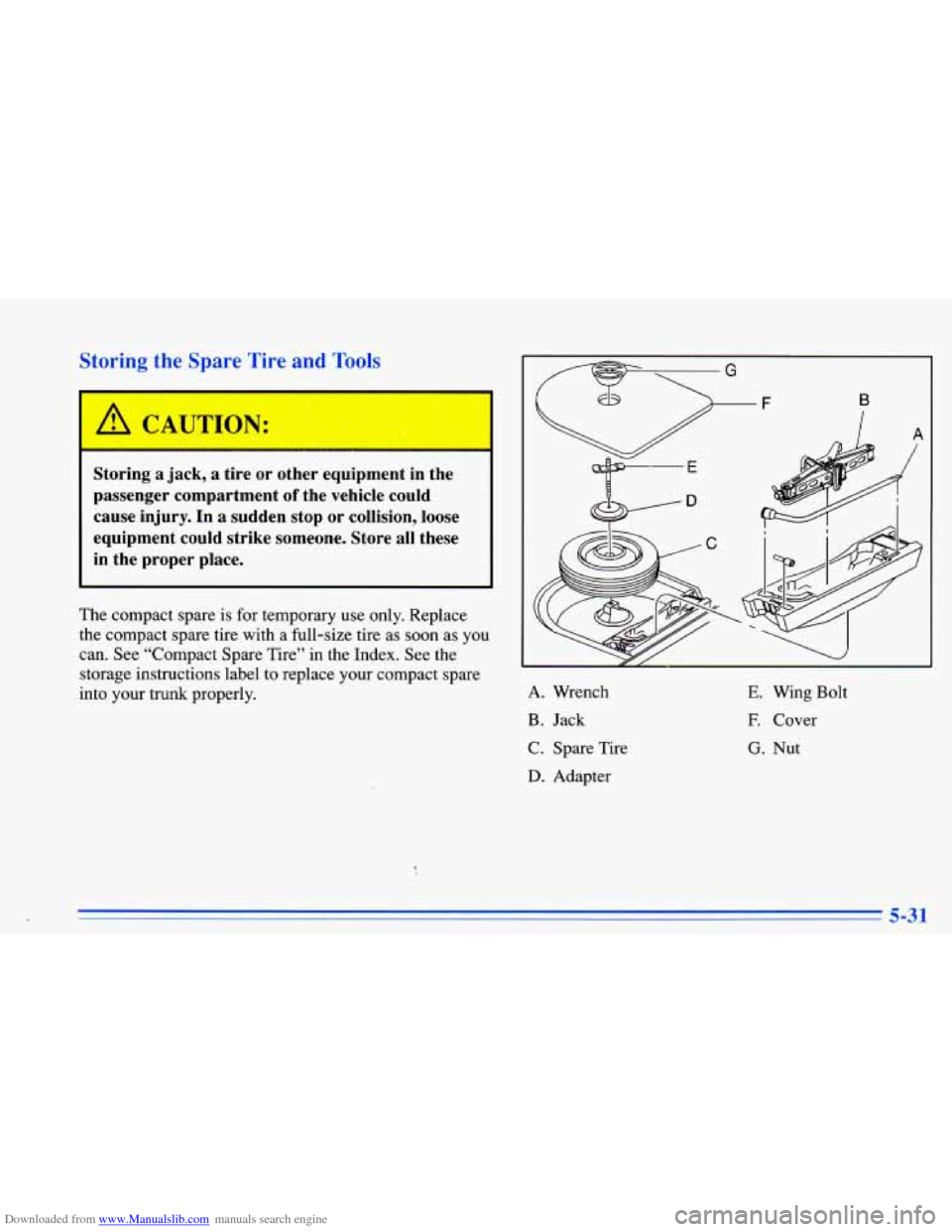
Downloaded from www.Manualslib.com manuals search engine oring thc “,P; e Tire and Tools
Storing a jack, a tire or other equipment in the
passenger compartment
of the vehicle could
cause injury. In a sudden stop or collision, loose
equipment could strike someone. Store all these
in the proper place.
The compact spare is for temporary use only. Replace
the compact spare tire with a full-size tire as
soon as you
can. See “Compact Spare Tire” in the Index. See the
storage instructions label to replace your compact spare
into your trunk properly.
m G
F B
A. Wrench
B. Jack
C. Spare Tire
D. Adapter
E. Wing Bolt
E Cover
G. Nut
5-31
Page 236 of 372
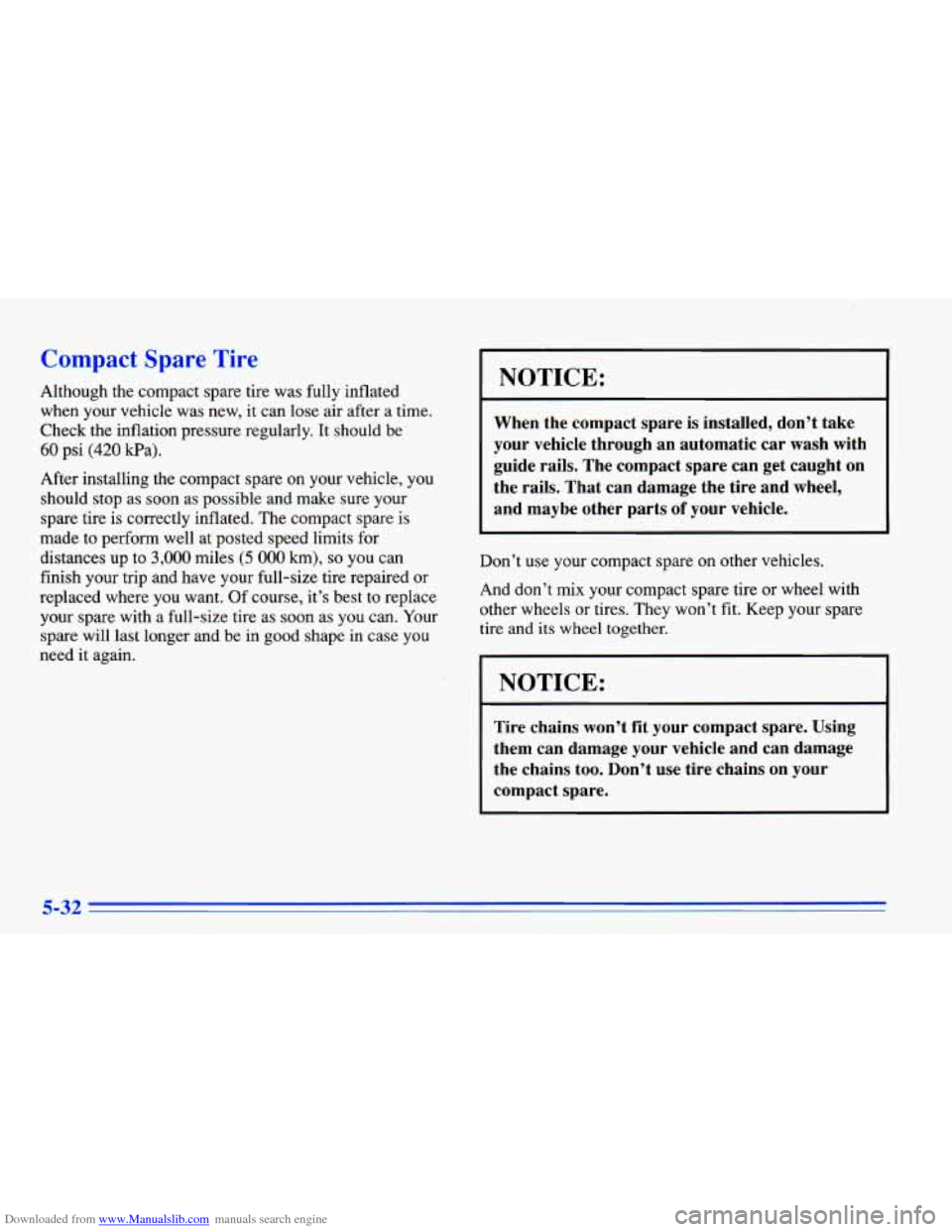
Downloaded from www.Manualslib.com manuals search engine Compact Spare Tire
Although the compact spare tire was fully inflated
when your vehicle was new, it can lose air after a time.
Check the inflation pressure regularly.
It should be
60 psi (420 ea).
After installing the compact spare
on your vehicle, you
should stop as soon as possible and make sure your
spare tire is correctly inflated. The compact spare is
made to perform well at posted speed limits for
distances up to
3,000 miles (5 000 km), so you can
finish your trip and have your full-size tire repaired or
replaced where you want.
Of course, it’s best to replace
your spare with a full-size tire
as soon as you can. Your
spare will last longer and be in good shape in case you
need it again.
NOTICE:
When the compact spare is installed, don’t take
your vehicle through an automatic
car wash with
guide rails. The compact spare can get caught on
the rails. That can damage the tire and wheel,
and maybe other parts
of your vehicle.
Don’t use your compact spare
on other vehicles.
And don’t mix your compact spare tire or wheel with
other wheels or tires. They won’t fit. Keep your spare
tire and its wheel together.
I NOTICE:
Tire chains won’t fit your compact spare. Using
them can damage your vehicle and can damage
the chains
too. Don’t use tire chains on your
compact spare.
5-32
Page 275 of 372
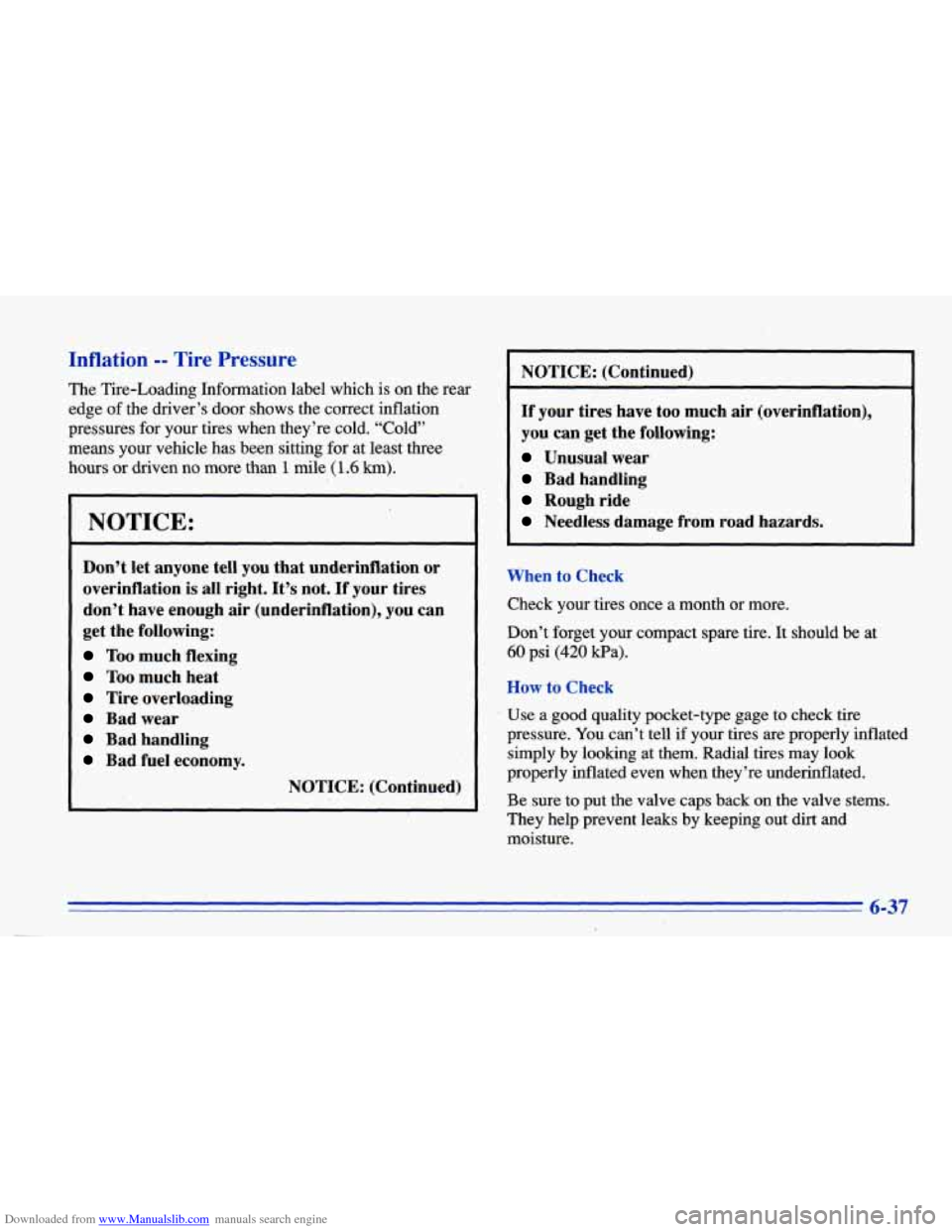
Downloaded from www.Manualslib.com manuals search engine Inflation -- Tire Pressure
The Tire-Loading Information label which is on the rear
edge
of the driver’s door shows the correct inflation
pressures for your tires when they’re cold. “Cold”
means your
vehicle has been sitting for at least three
hours or driven no more than
1 mile (1.6 km).
NOTICE:
Don’t let anyone tell you that underinflation or
overinflation is
all right. It’s not. If your tires
don’t have enough air (underinflation), you can
get the following:
Too much flexing
Too much heat
Tire overloading
Bad wear
Bad handling
Bad fuel economy.
NOTICE: (Continued) NOTICE:
(Continued)
If your tires have too much air (overinflation),
you can get the following:
Unusual wear
Bad handling
Rough ride
Needless damage from road hazards.
When to Check
Check your tires once a month or more.
Don’t forget your compact spare tire.
It should be at
60 psi (420 Pa).
How to Check
Use a good quality pocket-type gage to check tire
pressure. You can’t tell
if your tires are properly inflated
simply by looking at them. Radial tires may look
properly inflated even when they’re underinflated.
Be sure
to put the valve caps back on the valve stems.
They help prevent leaks by keeping out dirt and
moisture.
6-37